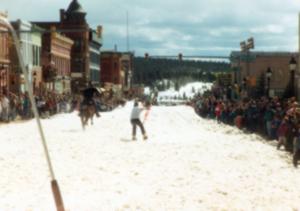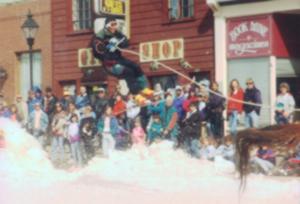Article by Lynda La Rocca
Leadville – March 2002 – Colorado Central Magazine
AS THE SONG SAYS, the times, they are a-changin’ — in Leadville as in many other small Colorado communities.
While the Crystal Carnival, Leadville’s traditional winter celebration, is now little more than a name and a memory, skijoring is still going strong.
And 2002 promises to be another year of thrills and chills for this wildest and weirdest of mountain sports.

On March 2 and 3, more than 50 skijoring teams from four states will gather on downtown Leadville’s Harrison Avenue to traverse an obstacle course at speeds even Superman might envy.
Meanwhile, former Crystal Carnival organizers lament the demise of one of Leadville’s most popular festivals.
“The Crystal Carnival was such an important part of our community for so long,” says Leadville native and former Crystal Carnival committee member Joann Cirullo.
As recently as 1996, its last “official” year, the Crystal Carnival remained an action-packed weekend of torchlight parades, snowmobile and sled-dog races, a grand ball, a dessert-tasting fair, even a fireworks display atop Mount Elbert, courtesy of several intrepid committee members who trekked to the 14,433-foot summit to put on the show. And of course there was skijoring, which has traditionally been held during Crystal Carnival weekend, although it has been a wholly separate event for more than 20 years.
“Those Grand Assembly Balls used to draw about 300 people annually, all dressed in formal or Victorian attire,” Cirullo recalls.
So what happened? “Many of the people who organized the Crystal Carnival have moved on,” says Maureen Scanlon, director of the Leadville/Lake County Area Chamber of Commerce.
After Leadville’s mining-based economy collapsed in the 1980s with the closing of the Climax molybdenum mine, a succession of community volunteers packed up and headed to areas where jobs were more plentiful. When no one stepped in to fill their shoes, events like the Crystal Carnival and the summertime Oro City festival — the latter a huge draw from the mid-1980s to the early 1990s — died slow, albeit natural, deaths.
“Leadville has a different personality now, and as its personality changed, priorities also changed,” Cirullo points out. “People have to drive 40 or 60 miles just to get to work today, so they don’t have the energy to participate in time-consuming activities like planning the Crystal Carnival.”
Yet despite societal and economic upheaval, other Leadville events, like Boom Days each August (a festival which Cirullo has long helped organize) and skijoring, continue to thrive.
And that’s due to dedication, hard work and, in the case of skijoring, a group of athletes who are definitely passionate — some might even say crazy — about their sport.

SEVERAL CENTURIES AGO, when Scandinavians strapped on crude skis, attached reins to reindeer, and used the animals to pull them over frozen expanses of Arctic tundra, they probably never imagined that their inventive means of transportation would one day morph into a highly competitive sport.
While Nordic skijoring still employs reindeer — hauling a skier around an oval track devoid of obstacles — good old Yankee ingenuity has turned the North American version into a kind of Wild West rodeo on skis.
Think you’d like to try skijoring? Then imagine yourself on slalom skis (the kind preferred by most skijorers), racing along a slippery, snowpacked obstacle course while clinging with one hand to a rope — a rope attached to the saddle of a horse being ridden through the snow at nearly 40 miles per hour.
“It’s an incredibly exciting sport,” declares longtime skijorer Paul Copper, who organizes Leadville events with Joe “Jody” Manly. “But you really have to be right there and watch some skijoring to understand what it’s actually like.”
To prepare for a skijoring run, skier and rider secure one end of a 33-foot-long tow rope to the horse’s saddle horn. The skier loops the rope’s opposite end around the left hand and clutches a baton in the right hand.
Then they’re off, the horse in full gallop down a straight course 675-to-900 feet long (Leadville’s is about 800 feet), while the skier behind it flies through a series of gates, soars over three jumps four-to-seven feet high, and spears two sets of dangling rings by wielding the baton like the lance of a medieval knight at a joust.
When it’s over, in less than 16 seconds, a team is judged by its skier’s speed and the cleanness of the run: A penalty-free run may score higher than a faster run marred by dropped rings or missed jumps or gates.
But my favorite rule, the one that best captures the spirit of skijoring, states that skiers “must be in an upright position and on at least one ski” when crossing the finish line.
That’s easier said than done. Skiers are sometimes yanked right out of their bindings by overeager horses. A split-second lapse in concentration can also plant skiers face down in the snow or turn them into flying projectiles. And because the skier’s side-to-side movements actually increase his or her speed over the horse’s by more than 10 mph, a skier may flash by at up to 50 mph, spraying snow at crowds lining the course just a couple dozen feet away.
And riding the horse is even more dangerous, says Copper, one of the few competitors who both rides and skis, because horses can be so unpredictable.
More than 2,000 spectators are anticipated at Leadville’s skijoring events, which are sanctioned by the North American Ski Joring Association (NASJA).
The skijoring competition is free to the public.
Registration for entrants begins at 9 a.m. on both March 2 and 3, with men’s races starting at approximately 1:30 p.m. each day. Women’s and children’s skijoring, staged on the same course but with jumps and/or rings eliminated and the youngest competitors pulled by snowmobile, will begin each day after registration is complete.
For more information, contact Paul Copper at 719-486-0739, or visit the NASJA website at www.nasja.com
Lynda La Rocca teaches in Leadville and writes from Twin Lakes.

